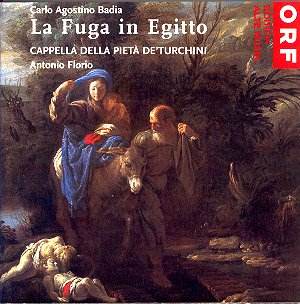One of the causes of the ‘crisis’ in the music
industry is the fact that too many works are recorded over and
over again. There are innumerable CDs with Vivaldi’s Four Seasons
or Pergolesi’s Stabat mater. But once in a while someone has the
imagination to perform and record a completely unknown piece by
a composer hardly anybody has ever heard about.
Antonio Florio is one of those creative minds
who concentrates on little-known repertoire. In the last decade
or so he has explored the musical past of his city, Naples. This
time he presents a composition by an Italian who, for the largest
part of his life, worked in Vienna. Badia was born in Verona and
went to Innsbruck at a young age. There the step-sister of emperor
Leopold I, Eleonore Maria, had her own court. Badia became her
court composer and wrote oratorios to be performed during Holy
Week from 1691 to 1693. He also composed an opera, performed in
1692. In 1694 Eleonore Maria moved to Vienna. There Badia became
court composer at the court of Leopold I himself, alongside his
fellow Italian Antonio Draghi. And in the following years he got
some colleagues who are still well known and respected: Fux, Torelli
and Giovanni Bononcini.
During his years in Vienna Badia composed oratorios
for the Ursulines, who on the feast day of their patroness, St
Ursula (October 21), offered the emperor a musical performance.
Badia was also sent to Rome to study, married a singer, composed
an oratorio for Venice and an opera for the court at Dresden.
In 1703 he was given the libretto of the oratorio ‘La Fuga in
Egitto del Patriarca S. Giuseppe con Giesù e Maria’, composed
by Giovanni Maria Casini, organist at Florence, and performed
there in 1697. The emperor himself had a copy of the libretto
and since he liked it, he handed it over to Badia. In 1703 the
Ursulines sang the work before the imperial couple who had come
to visit their convent on St Ursula’s Day.
The scoring is sober: five solo voices, which
also sing the ‘Coro’ sections, with two violins, viola and basso
continuo. Anyone familiar with the dramatic vocal works of the
baroque period will not be surprised by the predominance of high
voices. On the one hand this reflects the aesthetic ideals of
the baroque, on the other hand it met the popular preference for
virtuoso castratos singing the main roles in operas and oratorios.
But in this particular case it has nothing to do with the fascination
for castratos. There was a simple and very practical reason: all
the roles were supposed to be sung by the nuns themselves. The
only lower part is that of San Giuseppe, who is a tenor, but even
that role was probably sung by a nun. It is known from women’s
convents in Italy that some women were able to sing some tenor
parts.
Strictly speaking this work is anonymous: the
manuscript doesn’t give a date or the name of the composer. But
since there is a copy of the libretto of a performance by the
Ursulines in 1703 with Badia’s name on it, the attribution of
the oratorio to him seems to be reasonable.
The libretto is based upon the story of Joseph
and Mary, urged by the angel to flee to Egypt to escape the slaughter
of little children in Bethlehem by king Herod, as told in the
gospel according to St Matthew (2:13-18). The story itself is
dramatized, as is the case with so many biblical oratorios of
the time. These are in fact religious operas, stylistically not
very different from real operas. In this case, though, there is
little interaction between the protagonists. Short recitatives
are mostly followed by an aria, most of them da capo arias, but
some relatively short (less than two minutes). The most dramatic
moment is in the second part, when Herod decides – against the
advice of his Counsellor (Consigliere) - to slaughter all recently
born children, hoping to kill the newborn King (Jesus) with them.
There is nothing wrong with the music, though.
There is a lot of expression, both in the arias and the recitatives.
The fugue does appear in the score on a regular basis, probably
inspired by the title of the work.
There is (almost) nothing wrong with the performance
either. Most singers are well-known representatives of the Italian
baroque scene who regularly work with Antonio Florio. The casting
is very good. I was in particular impressed by Daniela Del Monaco,
whose low voice – going down well into the tenor range – is supremely
qualified for the role of Herod, the villain of the piece.
I am very happy with the rhythmically free way
the recitatives are dealt with, which gives the impression that
the singers are really ‘acting’ the roles they sing. The arias
are also done very well, with nice ornamentation. In the ‘Coro’
sections, sung by the soloists, the blending is excellent.
All the singers being Italian, pronunciation
is no problem. The only reservation I have in this regard is that
the ‘r’ is a little too strongly projected by some singers (in
particular Emanuela Galli and Rosario Totaro), whereas the preceding
vowels are sometimes too short and lack clarity.
The ensemble gives the singers excellent support
and their playing is lively and technically assured. The fact
that this is a live recording results in some minor technical
shortcomings, like a lack of synchronisation here and there, but
on the whole this minor defect is hardly worth mentioning.
In short: this is a very good recording of a
nice work, which I wholeheartedly recommend, in particular to
the inquisitive among us.
Johan van Veen
